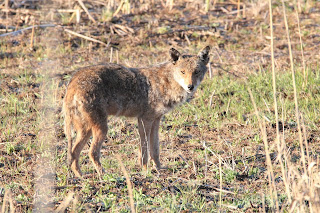The first of May is always a celebrated day for birders (or at least, it is for me!). I like to get out and start the month off right!
This morning, somehow I slept through my alarm, but nevertheless, I was out and about in the neighbourhood by shortly after 7:00. The last couple days haven't been really conducive for migrants, but on my walk over, I heard a couple House Wrens, new arrivals, so my hopes were up.
At the Northbrook Park/Wetland storm pond, I found a Solitary Sandpiper. I had heard one here the day prior, but it was nice to get a visual.
At one point I looked over and was shocked to see this staring back at me from the dried up wetland!
A Coyote! Although I have heard them on occasion in the neighbourhood, and commonly come across their scat, I very rarely actually see them (this is actually only my second time seeing one around here). It appeared to be quite mangey, and walked with a limp, so unfortunately I fear it was not well.
It went and laid down on some phragmites, and was napping (I hope) when I passed by it again an hour later.
As for birds, the Blue Jays were moving, and I counted well over one hundred.
A Brown Thrasher was making the rounds as well.
There wasn't really much else in the way of migrants other than a Blue-headed Vireo, my first this year. Not a single warbler at this location!
My next stop at the north wetland yielded the warblers, and I found Yellow, Yellow-rumped, and Palm. There were several Tree Swallows around, including this one, which was collecting nesting material off the path. There is a pair building a nest in a snag—will keep an eye on it for the breeding bird atlas.
Speaking of breeding birds, there was a House Finch sitting on the nest I spotted a few days back, and I saw my first brood of Mallard ducklings of the spring!
There was a small movement of Broad-winged Hawks, and I saw four go over.
Next up was to check the Uplands Trail. I flushed a Wilson's Snipe while walking through the field, probably the most interesting thing there. There was also a Pine Warbler singing.
I got distracted by the sedges. I saw my first "getting there" Graceful Sedge (Carex gracillima) of the year. The perigynia (fruits) on this species are short and plump without a "beak".
The terminal spikelets of this species are also what we call "gynecandrous", meaning that there are female flowers above the male flowers. You can kind of see that here (although it may not be super obvious if you don't know what you're looking for!). The gynecandrous tendency of Graceful Sedge is a distinguishing feature, separating it from most of the other similar species in Carex sect. Hymenlochaenae (this is a trait only shared by C. prasina, C. davisii, and C. formosa, all of which are not commonly encountered in Ontario).
Pennsylvania Sedge (Carex pensylvanica) is a species I have portrayed on this blog before. It's colony forming habits make it a pretty distinctive and easy to identify species once you are familiar with it.
Another species I saw was Fibrous-rooted Sedge (Carex communis). This can appear similar to Pennsylvania Sedge, although it is more clump forming and not colonial. The leaves are also wider, and the bracts (specialized leaf below the flowering part) are longer.
A feature I don't see discussed too much is that the bract sheath has reddish margins were it meets the culm (sort of like the 'stem' in grasses and sedges). I believe that is is fairly diagnostic of Fibrous-rooted Sedge, at least in species that it looks similar to (Carex sect. Acrocystis).
I'll finish off with this Mayapple (Podophyllum peltatum) with a "leaf necklace".
It was a great way to kick off May, and things can only look up from here!


















No comments:
Post a Comment